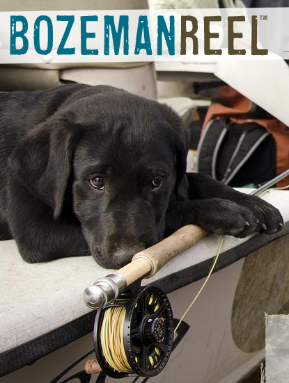Imagine a roaring freestone nestled in thick pines with smooth, round rocks scattered throughout it's tealish water. For me, this is exactly what I picture when I hear pocket water - a term used to describe a beat of water with many pools and eddies. Pocket water is a good thing due to the abundance of oxygen and shelter, two things that trout and trout food love. Most fly fisherman would tackle this scenario with some tungsten bead heads and an indicator. Well, I'm here to say screw that! In this article I am going to outline what, in my opinion, is the best approach to fishing these pockets with a streamer.
Reading the Water
Trying to dissect a section pocket water can be overwhelming
at first. What you need to focus on first is finding the "hot spots."
What's a hot spot? Well in streamer fishing, a hot spot is wherever you think a
trout will be hiding out ready to ambush it's prey. Remember, you aren't targeting nymph fish,
likely to be in the middle of the run. These are smart, calculated fish that
hide in the smallest nooks, eager to mangle a sculpin. Below is an illustration
to point out what I would consider to be hot spots.
Choosing Your Meat
Like nymphing, choosing the correct streamer pattern is
crucial to your success, especially in conditions like these. There are three
things I want you to ALWAYS keep in mind, whether you're out there:
In pocket water, you're almost always going to want some weight, so a Sculpin helmet or dumbell eyes are an absolute must. The addition of weight to your fly (or through the use of a poly leader) will allow you to quickly and effectively reach the bottom of swiftly flowing pools where fish will be likely to ambush. Next, take a look at the water; a good rule of thumb is natural colors in clear water (olives, tan, rust) and exotic colors in merky (black, purple, fire tiger, white). As for the weather, if it is sunny take advantage and use something a bit flashier. When the sun is out, everything in the stream lights up. On the contrary, when it is cloudy, flash can deter a fish. In other words, look up, look down, then pick your fly. Take these three factors into consideration when choosing your meat.
- Water Clarity
- Water Depth/Characteristics
- Weather
In pocket water, you're almost always going to want some weight, so a Sculpin helmet or dumbell eyes are an absolute must. The addition of weight to your fly (or through the use of a poly leader) will allow you to quickly and effectively reach the bottom of swiftly flowing pools where fish will be likely to ambush. Next, take a look at the water; a good rule of thumb is natural colors in clear water (olives, tan, rust) and exotic colors in merky (black, purple, fire tiger, white). As for the weather, if it is sunny take advantage and use something a bit flashier. When the sun is out, everything in the stream lights up. On the contrary, when it is cloudy, flash can deter a fish. In other words, look up, look down, then pick your fly. Take these three factors into consideration when choosing your meat.
How to Fish the Water
Arguably the most important aspect of streamer fishing is
how you cast and retrieve your fly. If you think it is a matter of double
hauling, and stripping, the fish will soon let you know that you are sadly mistaken.
By taking the time to understand and observe what your fly is doing under the water, even specific for different patterns, you will realize there is an entire art to streamer fishing you once never knew. Below are a few of the key points I like to focus on when I approach pocket water.
By taking the time to understand and observe what your fly is doing under the water, even specific for different patterns, you will realize there is an entire art to streamer fishing you once never knew. Below are a few of the key points I like to focus on when I approach pocket water.
- Make Your First Cast Your BEST Cast - In these conditions, 9 times out of 10 your targeted species will strike within a few strips of your first cast. These fish are ambush predators and will make haste for a tasty snack. The second your fly hit's the water you need to be connected with your fly. I do this by making one long strip as I lift my rod tip, ensuring that there is NO slack between you and your fly.
 |
| A Brown that ate a Pocket Rocket on the second strip |
- Get to the Hot Spots - Those hot spots we mentioned earlier can be
fished in many ways, but getting your fly to them is the tricky part. First,
think about this:
When a baitfish is evading it's predator, it definitely isn't going to swim upstream, it is going to turn downstream and get the hell outta dodge!
You should fish your streamer similarly. Land it as close to the bank or rock as you can, get connected, and swim your fly in every single crevasse you can see. Your fly will pass more fish than you can imagine, as they hide all over. This is what will turn your 5 fish days into 20 fish days. Fish. Are. Everywhere. So make sure you hit every seam in that riffle before you move on, because although streamers cover a lot of water, fish will sit in pools smaller than you can imagine. Below is an illustration to show how I would swim my fly down this beat of water. As you can see, there are plenty of casts to make, which I will address next.
 |
| An example of effective paths to swim your streamer down |
- Stop False Casting - I don't care how tight you think your loops are, stop false casting so much. This style of streamer fishing is not about quiet, perfectly laid down casts...it's about covering your water effectively. Plop your fly in a hole (it's like a dinner bell in that loud water), and get in contact. Swim your fly down one of the orange paths above, and when your fly is either in unfishable water or at your feet, raise the tip of your rod and fire that meat to your next line. So many people spend more time false casting than actually fishing. If you limit yourself to one or two false casts, your fly will spend much more time in the water, resulting in more fish; it's as simple as that! Learn how to single and double haul too, as it can be extremely helpful when launching a sculpin, with a single hauled roll cast, across the way.
Streamer fishing pocket water can be extremely effective
when done properly. If you consistently focus on getting your fly into places trout
will be, you will catch fish! Just
remember to stay connected, read your water, and find those hot spots. The
trout will do the rest!
Ty























